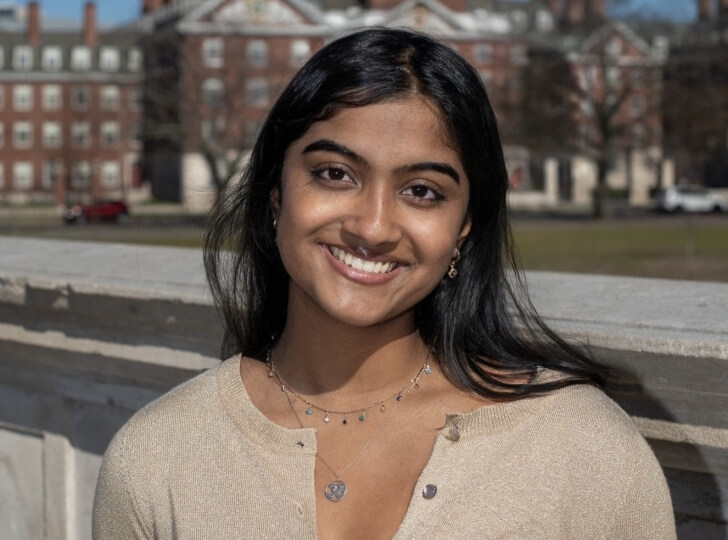News
Shivani Srikanth, A.B. '26
If anyone would want to do cardiac research at Boston Children’s Hospital (BCH), it’s Shivani Srikanth. As a child, Srikanth had a heart condition that required a pacemaker to be surgically implanted, and the procedure was done at BCH. Now a fourth-year bioengineering concentrator at the Harvard John A. Paulson School of Engineering and Applied Sciences (SEAS), Srikanth spent this past summer interning with the Vassilios Bezzerides Research Group in BCH’s cardiology department. Srikanth is now continuing her inquiry for “ES91R: Research for Course Credit,” which allows students completing A.B. degrees to pursue theses similar to the required senior capstone project for S.B. students.
“It felt very full circle to be working at the cardiology department here, doing research and modeling disease conditions similar to mine,” Srikanth said. “I think there's a little bit of everything that has come together for me, and with this project it just feels very personal.”
Srikanth was already familiar with laboratory settings when she arrived at BCH, having spent two years as an undergraduate researcher in the lab of Joanna Aizenberg, Amy Smith Berylson Professor of Materials Science, plus several shorter stints in other SEAS labs. The Aizenberg Lab exposed her to engineering in a research setting, as one of her main projects was studying the reflective qualities of butterfly wings as inspiration for designing climate-resilient construction materials inspired by those qualities. Later, she worked on a collaboration between Dr. Aizenberg Lab and Eric Mazur Group, studying integrated laser-microfluidics systems for applications in drug delivery. This broadened her interests, as she delved into optical physics, device design, and molecular mechanics.
For her final summer at SEAS, Srikanth wanted to dive deeper into the translational side of bioengineering, leading her to reach out to Bezzerides, who is also an Assistant Professor of Pediatrics at Harvard Medical School. This led to studying and adapting the process for converting stem cells into functioning cardiac cells, a method known as differentiation. By generating cardiac tissue in a laboratory setting, it becomes much easier to accurately model diseases and tailor potential treatments to a specific patient.
“The goal is to identify solutions for cardiac disorders, and model them in a way that is very individualized,” she said. “Broadly, cardiac disease and disorders, where patients experience anything from arrhythmias to heart failure, are a leading cause of death in the US and globally. So there's a critical need to mimic heart tissue in the lab with stem cells and tissue engineering.”
This stem cell differentiation process is typically used to generate organoids composed of ventricular and atrial cells. Srikanth’s research involved exploring whether that same process could be modified and optimized to produce highly specific cardiac cell subtypes, which would enable advanced treatment for a broader range of conditions.
“I've been really excited about the translatability from the lab to patients in the hospital who might be benefiting from academic research,” she said. “The lab itself is situated right next to Boston Children's Hospital, so you often can see real impact in terms of where some of these solutions or findings are going to be implemented.”
Heart disease modeling and butterfly-inspired building materials might not seem to have much in common. However, these two experiences have been instrumental in helping Srikanth locate the exact space within bioengineering that most fascinates her.
“I'm interested in bio-inspired regenerative medicine as a field,” she said. “My Aizenberg Lab research experience made me think about how the human body, ecology, and nature already hold a lot of the answers for our problems, and we just have to understand how to harness those lessons in ethical ways. With stem cells, you're leveraging the human body to generate more tissue in a circular way. The solutions already lie in our environments, which is something that's very exciting to me.”
As she continues her research this year, Srikanth is also hoping to shadow more doctors to further understand how laboratory research translates to surgical implantation and real-life diagnosis. She plans to pursue a graduate degree after finishing at SEAS, and her research experiences both at SEAS and at BCH are big reasons why she wants to stay in academia.
“Both non-hospital lab research and hospital lab research are worth exploring as an undergrad,” she said. “University labs are able to help students learn complex skills, develop solutions for far-reaching problems, and diversify their interests. With hospital research, there is an urgency that comes up when you consider patients who are desperately in need of treatment. It feels serendipitous to be working in a place that is very personal to me and feels almost like the culmination of the skills and experiences that I've built up over time.”
Topics: Bioengineering, Health / Medicine, Undergraduate Student Profile
Cutting-edge science delivered direct to your inbox.
Join the Harvard SEAS mailing list.
Press Contact
Matt Goisman | mgoisman@g.harvard.edu



